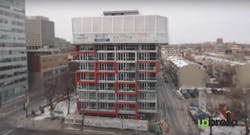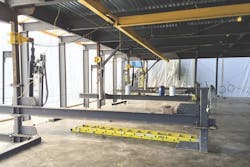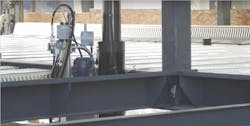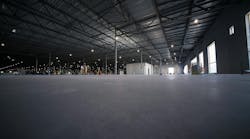Raising the roof is cool again
In popular culture, it hasn’t been cool to “raise the roof” since the late 1990s. But one company is trying to start a new, very literal “raise the roof” trend in the AEC industry.
That company is Upbrella Construction (upbrella.com), and the trend is to build the roof of a structure early in the construction process, and then raise it up as the building progresses.
This alternative process for building tall concrete or steel buildings consists of a mobile permanent roof, a roof lifting mechanism, a protective enclosure, and a high-capacity hoist.
The first step of the Upbrella process begins as soon as the first repeating floor is completed on the foundation. During this phase, an adapted roof that is suitable and equipped to support the construction is installed. The roof can remain on the building throughout construction and after the building is completed if it has the desired geometry. It can also be adapted at the end of the project.
Once the roof is in place, a protective enclosure, consisting of a metal structure covered with a reinforced canvas, is installed up to the parapet and descends to the working gateway. This enclosure keeps the work environment and the workers completely sheltered and allows the project team to better control risks associated with construction.
The floor above is assembled on the previous floor inside the sheltered environment and then positioned using the adapted roof and its hoisting system. The subassembly is finished prior to positioning it to its final height. Once the floor is installed, the entire roof system is raised and work can progress to the next level, where the process is repeated.
See Also: When is wood not really wood?
A large-format carrier replaces conventional elevators and can route all the necessary workers and building materials to the floors. The hoist comprises at least two masts anchored to the structure and remains in place during the entirety of the construction period. The capacity and quantity of the carriers can be adjusted to the size and scope of the project.
The adaptable roof and associated protective enclosure allow for finishing touches and occupancy of the lower floors faster. If sales stagnate, construction can be suspended while the completed floors can become and remain occupied. Then, if sales or demand increase, construction can quickly proceed once more.
Other benefits the company cites: reduced insurance costs; the elimination of lost days due to inclement weather; the reduction of overhead and high winter costs; an increased energy efficiency for the building site; and the reduction of public occupancy costs.




